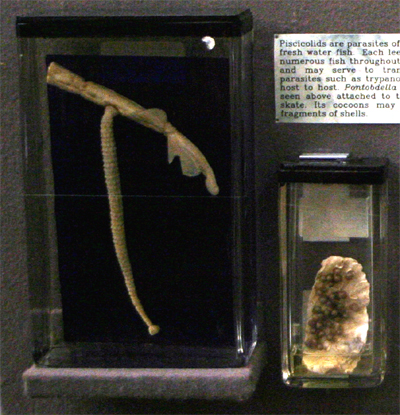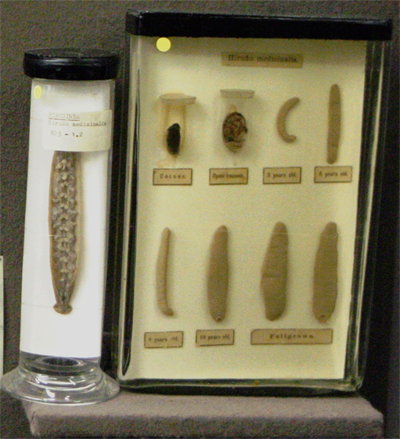
CLASS HIRUDINEA | |
Leeches (500 species) lack parapodia and are usually without chaetae. They are distinguished by their two suckers - one anterior surrounding the mouth, the other posterior. As the dissection of the medicinal leech, Hirudo medicinalis, shows their bodies are flattened with 32 segments, but each segment has several external grooves. All move by looping movements of the body using suckers at each to attach to the substrate. Leeches are hermaphrodite with similar reproductive behaviour to oligochaetes from which they appear to have evolved. Eggs are fertilised internally and laid in cocoons. Young leeches resemble their parents. Living in marine, fresh-water and terrestrial habitats many are external parasites using suckers to attach to their hosts. Some are ectoparasites of invertebrates, others of vertebrates. Leeches feed by attaching very tightly to the host’s integument with the anterior sucker and then slitting the skin. The pharynx provides continual suction while salivary secretions stop the blood clotting. Yet others are carnivores or detritus feeders. Used for many centuries for blood-letting, an early ‘cure’ for a multitude of ailments, Hirudo medicinalis is once again being used for medicinal purposes. It is being farmed for hylauronidase, an enzyme which improves the spread of drugs through the body. 
Piscicolids are parasites of marine and fresh water fish. Each leech feeds on numerous fish throughout its lifetime and may serve to transmit blood parasites such as trypanosomes from fish to fish. Pontobdella muricata is seen above attached to the tail of a skate. Its cocoons may be laid on the fragments of shells. |
 |






